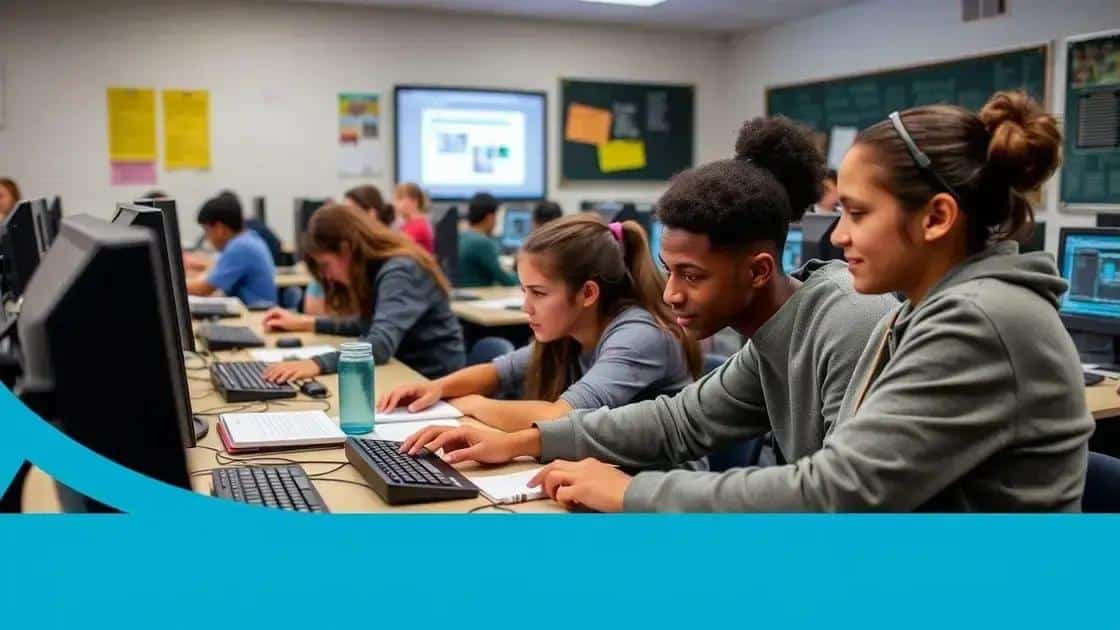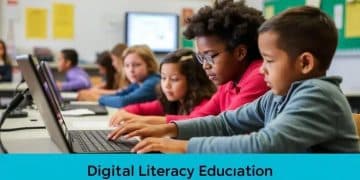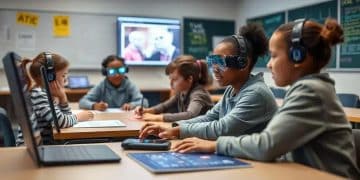Insights on high school coding classes that boost skills

Insights on high school coding classes demonstrate their significance in enhancing problem-solving skills, fostering creativity, and improving career readiness for students in today’s technology-driven world.
Insights on high school coding classes reveal their growing significance in today’s tech-driven world. Ever wondered how these classes can shape students’ futures? Let’s dive into the benefits and opportunities they provide.
Understanding the importance of coding in education
Understanding coding’s role in education is crucial in today’s digital landscape. Coding classes equip students with essential skills that promote logical thinking and creativity. As technology continues to evolve, the need for proficient coders grows.
The Impact of Coding on Problem-Solving
When students engage with coding, they learn to approach problems systematically. They break down complex tasks into smaller, manageable parts, which enhances their overall problem-solving abilities. This foundational skill not only applies to coding but also to various subjects and real-world situations.
Fostering Creativity Through Technology
Coding is not just about writing lines of code; it’s a form of expression. Students can create games, apps, or websites, which allows them to bring their ideas to life. This creative outlet boosts their confidence and encourages innovative thinking.
- The ability to create is empowering.
- Students can experiment with their ideas freely.
- Understanding coding allows for collaboration on tech projects.
Many schools are now integrating coding into their curriculum. This inclusion helps students develop a strong technical foundation early on. Through collaborative projects, students learn teamwork while sharpening their coding skills.
Moreover, coding teaches persistence. As students encounter challenges, they learn the importance of trial and error. This resilience is vital for their future careers, regardless of the industry they choose to pursue.
Connecting Coding to Real-World Applications
Understanding the importance of coding extends beyond the classroom. In today’s job market, many roles require some level of coding knowledge. Familiarizing students with these concepts early can enhance their career readiness.
With technology influencing every aspect of our lives, coding skills can open doors to numerous opportunities. From software development to data analysis, the skills they acquire now will be beneficial in their future.
Top benefits of learning coding in high school

Learning coding in high school offers multiple benefits that extend beyond just understanding technology. Coding helps students build essential skills that are valuable in many areas of life.
Enhancing Logical Thinking
Coding encourages students to think logically and methodically. It teaches them to break down problems into smaller, manageable parts. This skill not only helps in coding but also enhances academic performance across various subjects.
Boosting Career Opportunities
With the increasing demand for tech skills in the job market, understanding coding can significantly boost a student’s career opportunities. Many fields now require basic coding knowledge, making it a valuable asset for future employment.
- Jobs in technology are thriving.
- Even non-tech roles can benefit from coding skills.
- Coding knowledge can lead to internships and job offers.
As students learn to code, they gain experience with teamwork and collaboration. Group projects foster communication skills, as they must work together to solve problems. This experience prepares them not only for the classroom but also for future workplaces.
Moreover, coding empowers students with a sense of accomplishment. As they complete projects or debug programs, they learn perseverance. This resilience is valuable when facing challenges—both in coding and in life.
Encouraging Creativity
Coding is a creative process. Students have the opportunity to build their own games, apps, or websites. This creativity encourages self-expression and allows students to explore their interests in a dynamic way.
Overall, the benefits of learning coding in high school are substantial. These skills prepare students not just for future jobs, but also for a world that increasingly relies on technology.
Best platforms and resources for coding classes
There are numerous platforms and resources available for students eager to learn coding. These platforms cater to different learning styles and skill levels, making coding accessible to everyone.
Online Learning Platforms
Many online platforms specialize in coding education. They provide structured courses that guide learners step by step. Some popular coding platforms include:
- Codecademy: Offers interactive coding lessons in various languages.
- Coursera: Features courses from top universities on coding and computer science.
- edX: Provides free courses from universities, allowing students to learn at their own pace.
These platforms often include projects and quizzes to enhance understanding. They make learning coding engaging and practical.
Interactive Coding Environments
Interactive platforms allow students to practice coding in real-time. This hands-on approach helps solidify their skills quickly. Examples include:
- Replit: A collaborative coding environment where students can code together.
- Glitch: Encourages creativity by allowing users to create apps and websites collaboratively.
- Scratch: A beginner-friendly platform that teaches coding by creating animations and games.
These environments are designed to make coding fun and accessible for younger audiences or beginners.
Additionally, coding bootcamps are intensive learning programs that focus on teaching coding skills in a short time. They often include real-world projects and career support. Some renowned bootcamps include:
- Flatiron School: Offers comprehensive coding programs with career support.
- General Assembly: Provides coding and tech courses tailored for beginners to advanced learners.
These bootcamps can help students jumpstart their coding careers.
How to integrate coding into the curriculum

Integrating coding into the school curriculum can transform how students learn and interact with technology. By weaving coding into various subjects, educators can empower students with essential skills for the future.
Cross-Disciplinary Projects
One effective way to include coding is through cross-disciplinary projects. For example, students can create programs that simulate scientific phenomena or develop games focusing on historical events. By combining coding with subjects like math or science, students can see real-world applications of their knowledge.
After-School Coding Clubs
Setting up after-school coding clubs encourages students to explore coding in a relaxed environment. These clubs can offer various resources, such as coding games or competitions. Programs like Code.org provide fantastic materials to guide novice coders, making learning fun and engaging.
- Encourage peer teaching—students can help each other learn.
- Host coding challenges to stimulate interest.
- Invite guest speakers from tech fields to inspire students.
Teachers can also adopt project-based learning approaches. By having students work on long-term coding projects, they develop persistence and teamwork skills. These projects can range from building websites to creating mobile apps, depending on students’ interests and abilities.
Incorporating Technology in All Subjects
Introducing coding into various subjects is essential. For instance, in language arts, students can use coding to create stories with interactive elements. This method blends creativity with technology, making learning exciting.
Additionally, integrating coding into mathematics helps students understand abstract concepts through tangible coding tasks. As they write programs to solve math problems, they build a solid foundation in both subjects.
To successfully integrate coding into the curriculum, ongoing professional development for teachers is crucial. Training sessions can equip educators with the necessary skills and resources. When teachers feel confident in teaching coding, students benefit greatly from the experience.
FAQ – Frequently Asked Questions about Coding in High School
What are the main benefits of learning coding in high school?
Learning coding enhances logical thinking, boosts creativity, and prepares students for various career opportunities.
How can coding be integrated into other subjects?
Coding can be integrated through cross-disciplinary projects, such as using coding to create simulations in science or interactive stories in language arts.
What resources are available for students to learn coding?
There are many online platforms, such as Codecademy and Coursera, as well as interactive environments like Scratch and Glitch that make learning coding fun.
Can coding skills impact future job opportunities?
Yes, coding skills are highly valued in today’s job market, and many careers require some level of coding knowledge.





